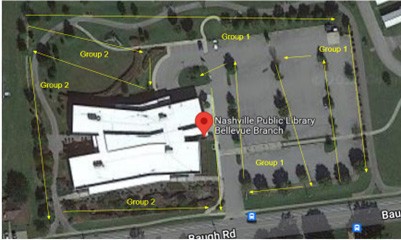Though neglected and declining in population, trees are a crucial part of Nashville that doesn’t have to wait until spring to learn about them. – Carlos Espinoza
We are a team of four high school students – Brady, Carlos, Jaxon and Roger – from the School for Science and Math at Vanderbilt’s (SSMV) Class of 2023 who recently had the opportunity to work with Metro Government through the Socket Initiative. Through our collaboration, we’ve gained many insights into Nashville’s sustainability efforts and Socket’s mission.
In our initial meetings with the Department of General Services, we first learned about the benefits of trees in our community and the importance of Root Nashville’s campaign to plant 500,000 trees by 2050. For example, one of the lesser-known benefits is that trees not only provide shade and coolness in the summer, but also allow more sunlight into the home in the winter due to the lack of leaves. In addition, we have gained a better understanding of how Nashville’s increasing urbanization is leading to an alarming loss of trees. We also took this time to understand the main purpose of our collaboration: to create a database and map of locations, sizes and types of trees so city employees can understand how they affect stormwater management and greenhouse gas emissions in different areas of Nashville.
Before traveling to different data collection sites, we had to make some preparations. We’ve adopted the general procedure for measuring tree diameters: Wrap a diameter tape around the trunk and branches at 4.5 feet off the ground (known as diameter chest height). This often required us to wrap our arms around the tree to connect the ends of the diameter tape, so we often had to “hug” the trees (hence the title of this blog). We also learned how to measure trees in exceptional circumstances, such as when there are more than six branches or when there is a swell at chest diameter. Overall, this allowed us to gain experience of the hands-on work that arborists and environmentalists do to better understand our habitat. As part of our preparations, we also developed our organizational skills by making plans for the campus walkthrough before we actually traversed it – this helped increase our efficiency.
Tree census campus plans at the Nashville Public Library Bellevue Branch
Now that we were ready to start our field work, we needed a means of transportation to take us to the very different places. With our Metro Nashville Public School badges, we were able to ride the Nashville public transit system known as WeGo Public Transit for free. In this way we got acquainted with the city and its public transport. We were very surprised how well the transport system was connected. At the beginning of each of our field work days, we could easily check which buses would take us to our destination and at what times.
This fieldwork eventually became one of our favorite aspects of the project. We got a better feel for applying the scientific concepts we had learned in class. Some of us also gained more awareness of the types of trees around us and in our communities. We have gained so much familiarity with the distinctive characteristics of certain tree species; For example, we can now distinguish the branched shape of a cherry tree from that of an elm, and we can tell the difference in bark between an oak and a birch. There are now times when we can recognize certain types of trees simply by going about our day. We have also learned to recognize mould, rot and infestation and to recognize the risks that trees with such health problems pose. All of this has really allowed us to appreciate the impact of trees on our surroundings.
 Students at the Vanderbilt School of Science and Mathematics measure the diameter of trees
Students at the Vanderbilt School of Science and Mathematics measure the diameter of trees
Ultimately, our collaboration with Metro Government and the Socket program gave us an opportunity to appreciate lesser-known aspects of trees, hone our communication and collaboration skills, and gain first-hand experience of how to use science not just in the abstract, but real ones as well remarkable benefits creates a sustainable future. We hope that the results of this project, as well as the Socket initiative, can raise public awareness of the role of trees in our community and help support Root Nashville’s cause to make Nashville an even more pleasant, healthier city.
 School for Science and Math group photo with Vanderbilt students
School for Science and Math group photo with Vanderbilt students
This blog was written by SSMV students Brady Huneycutt, Carlos Espinoza, Jaxon Draughon, and Roger Chen.
www.nashville.gov
https://www.nashville.gov/departments/general-services/news/what-hugging-nashvilles-trees-tells-us-about-them















